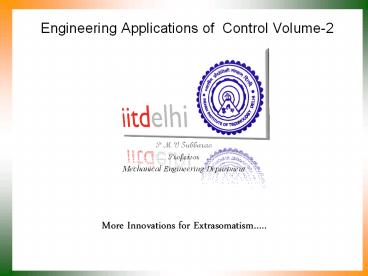Engineering%20Applications%20of%20Control%20Volume-2 - PowerPoint PPT Presentation
Title:
Engineering%20Applications%20of%20Control%20Volume-2
Description:
The fluids whose pv decreases during throttling generate cooling effect The Joule-Thomson Experiment ... process is governed by a property called Joule-Thomson ... – PowerPoint PPT presentation
Number of Views:111
Avg rating:3.0/5.0
Title: Engineering%20Applications%20of%20Control%20Volume-2
1
Engineering Applications of Control Volume-2
- P M V Subbarao
- Professor
- Mechanical Engineering Department
More Innovations for Extrasomatism..
2
Steam Power Plant A series of CVs in SSSF
3
Pumping of Incompressible Fluids
Adiabatic pumping of a liquid is almost an
Isothermal process!!
4
2 3 Steam Generation Isobaric Heating
QCV
- No work transfer, change in kinetic and potential
energies are negligible
5
Oil Fired Steam Boiler
6
Turbine Adiabatic Process
No heat transfer. Change in kinetic and potential
energies are negligible
Assuming a single fluid entering and leaving
7
Diagram of Large Power Plant Turbine
8
HP Turbine Rotor
9
LP Turbine Rotor
10
Highly compressible flow through Turbine
11
Steam Power Plant A series of CVs in SSSF
12
4 1 Condenser Isobaric Cooling p4 p1
QCV
4
1
No work transfer, change in kinetic and potential
energies are negligible
Assuming a single fluid entering and leaving
13
(No Transcript)
14
(No Transcript)
15
Schematic for PC Power Plant with cooling Water
from A River
16
Windcatcher (Bagdir)
17
Schematic for PC Power Plant with cooling tower
18
Air Cooled Condenser System
19
Net Heat and work Actions
- First law for a cycle
20
Turbojet Engine A Heat Engine with Single Phase
Non Pure Substance
Qin
Qout
Wout
21
Structure of A Domestic Refrigerator
1 Evaporator/Freezer 2 Condenser 3
Compressor 4 Throttling Device
22
Thermodynamic Cycle of A Refrigerator
23
(No Transcript)
24
Simplified Diagram of A Refrigerator
Condenser Transient Constant Pressure
Cooling. Compressor Transient adiabatic
Compression. Throttling Device Homogeneous and
Transient Isoenthalpic process. Evaporator
Transient Constant Pressure Cooling.
All the parts are CVs working in USUF processes.
25
Analysis of Uniform State Uniform Flow Devices
26
First Law for CVUniform State Uniform Flow
Properties of CV are variant
- Conservation of mass
Continuous Accumulation or/and depletion of mass
of a CV.
- Conservation of energy
Continual Addition or removal of energy for a CV.
27
Salient Features of CV _at_USUF Process
- Rate of mass inflow ? Rate mass outflow.
- The states of inflows and outflows are invariant
although the mass flow rates may be time varying. - Rate of Work done is variant.
- Rate of Heat transfer is variant.
- Change of state or process is both for the CV and
Flows! - The incoming fluid changes its state from
inlet(at one time t0) to exit (at time t0Dt)
condition. - A CV with USUF process is approximates as a
homogeneous but variant device. - The importance of time is very high!
28
CV following A USUF Process for time Dt
- A change of state occurs in a CV with USUF due to
change in time. - A total change in a CV over time Dt can be
calculated using
Total change in mass of A CV during a time
interval Dt
29
Total change in energy of A CV during a time
interval Dt
All parameters mentioned above are homogeneous
and variant.
30
Let us now integrate this equation over time Dt,
during which time we have
31
First Law for A CV executing USUF for finite time
32
Throttling Devices
- Throttling devices are any kind of flow
restricting devices. - They cause large pressure drop in the fluid.
- The pressure drop in fluid is often accompanied
by a large drop in temperature and rarely a raise
in temperature. - The magnitude of temperature drop or rise during
a throttling process is governed by a property
called Joule-Thomson Coefficient.
33
Throttling Valves
- Throttling Reduces Pressure
- Common Assumptions
- SSSF
- No work or heat transfer
- Neglect changes in PE and KE
- Energy Balance
Throttling Valve
34
- Isenthalpic (h constant) Process
Internal energy Flow energy Constant
The fluids whose pv increases during throttling
generate cooling effect. The fluids whose pv
decreases during throttling generate cooling
effect
35
The Joule-Thomson Experiment































